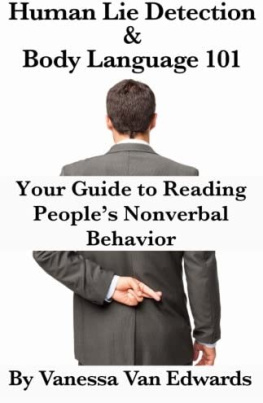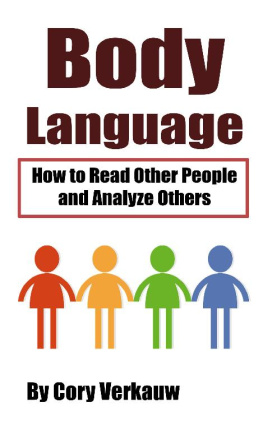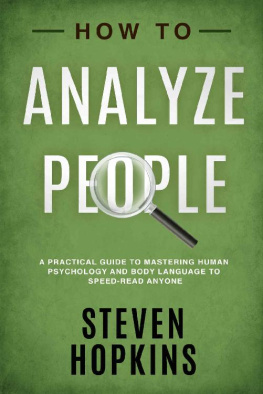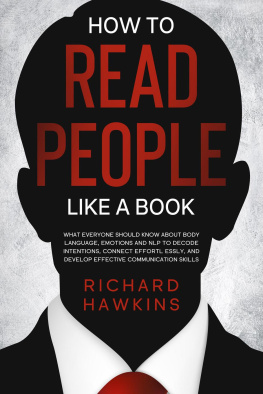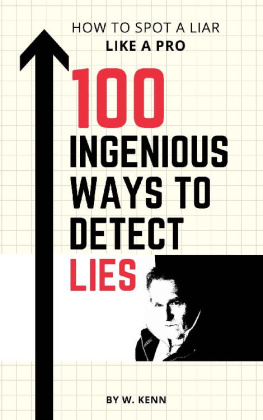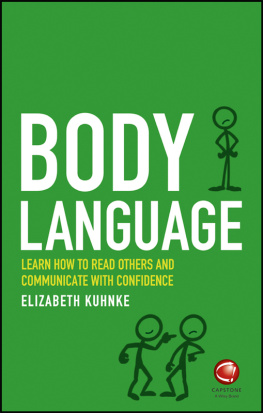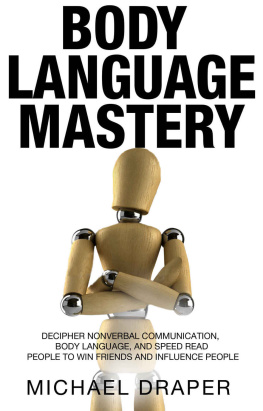Human Lie Detection and Body Language 101
Your Guide to Reading Peoples Nonverbal Behavior
By Vanessa Van Edwards
Please visit the ScienceofPeople.org for free video and article guides in addition to this book. 2013 Vanessa Van Edwards. All rights reserved. ISBN 978-1482040234
Table of ContentsIntroduction: Who Is This Book For?The Good News:
Do You Really Want to Know?
A Word of Caution
What to Expect
About Me:
Chapter 1: Baselining
How to Baseline:
The Importance of Rapport
Chapter 2: Microexpressions and the Face
Microexpressions:EyesMore About Head Behavior
A Lying Face
Chapter 3: Body Language
Feet
Legs
TorsoArm Behavior
Hand BehaviorBody Proxemics
Chapter 4: Vocal Displays, Voice Tone and Language Patterns Verbal Clues to DeceptionVoice Tone and Bonding
Chapter 5: Clues to Behavior Most Common Lying GesturesHow We React to Our Own Lies
Meanings of Other Everyday Gestures
How to Get Someone to Tell You More:
How to Get Someone to Confess:
Chapter 6: Your Nonverbal BehaviorYour Nonverbal Behavior
Why You Shouldnt Lie
How to Make A Great First Impression
Chapter 7: Special Areas
Interactions Between Men and Women: Dating, Romance and Love
Business Body Language and Nonverbal Behavior
Conclusion and Other Resources:
Appendix 1: Interview Tips
Appendix 2: Microexpressions
Appendix 3: Lance Armstrong
1.The Confession:
2. Why Now?
3. Doping Scheme
4. Anger and Holding Back
5. Suing Shame
6. Contempt At Recklessness
Appendix 4: Colors
Appendix 5: The Best Websites on Human Lie DetectionCitations
Notes:Introduction:
Have you ever thought someone was telling you a lie? Your intuition was probably righton average people tell two to three lies in a ten-minute conversation.
Even more frightening, 91% of people lie regularly at home and work. But we can detect these lies only about half of the timeno better than a coin toss.
Learning how to decode and interpret nonverbal behavior such as facial expressions, gestures, physical movements and vocal tone is an integral part of communication. As much as 93% of interpersonal communication is nonverbal, yet we often base all of our interactions on verbal content alone.
By using the latest scientific techniques summarized in this book, you will no longer doubt yourself or wonder helplessly if the person you are with is trying to deceive you.
Research has shown you can significantly improve your lie spotting and people reading ability by learning how to read nonverbal behavior.
All of the tips, cues and clues in this book are based on academic research. For a full list of my sources, you can see my citation section.
Who Is This Book For?Whether you are a teacher, businessman, police officer, husband, gardener or mother, this book is for you. If you have ever interacted with another person, this book can change the way you communicate with others.
Interesting Fact: Extroverts lie more than introverts.
Everyone should know more than 82% of lies go undetected.
Businesses should know corporate fraud cost us $997 billion in the United States in 2011, which is 7% of total annual revenue.
Parents should know college students lie to their moms one in every five interactions.
Human resource professionals and
entrepreneurs should know a third of all resumes contain false information.
Managers should know one in five employees say they are aware of fraud in their workplace.
Women should know men typically lie more often than females.
The Good News: Lying is learned, so we can unlearn it.
To test this fact, researchers left three year-olds in a room and told them not to peek at a concealed toy across the room. 90% of the children looked and when asked, 38% admitted that they broke the rules.
When researchers did the same experiment with five yearolds none of them admitted they broke the rules after peeking at the forbidden toy. Older children had learned, even at the young age of five, that they could get in trouble for telling the truth and decided to lie instead.
Lie spotting is about getting back to truth. This book is not about teaching you to pick peoples behavior apart or point fingers at liars. It is about arming you with scientific principles to help you have more honest interactions, better communication and more trustworthy relationships.
Interesting Fact: Researchers found that combining deception detecting
techniques with background checks can reveal 32% more cases of past job dismissals, 60% more criminal
convictions and 82% more cases of alcohol abuse during work hours.
Our brain is much more adept at spotting lies than we realize. When our brain picks up on a lie subconsciously we often have what we call, an intuition, that something is wrong, but we are not sure what. The tools in this book will help you bring that subconscious realization forward so you know exactly what you are seeing.
In one study, researchers had participants view 30 seconds of a mute video where a new professor was talking to his students. Just after that 30 second silent clip, the participants were able to correctly predict how well the teachers would do in their global evaluations at the end of the semesterjust from a 30 second clip!
Even when the researchers shortened the clip to two seconds, participants were still able to predict how the teacher would do in their evaluations at the end of the semester. Our brains are incredibly accurate.
Some people, nicknamed truth wizards, are able to naturally spot detection with incredible accuracy. Research from University of California found that 20 to 30% of these truth wizards had traumatic childhoods involving alcohol, an unstable home life, sexual, or emotional or physical abuse.
Researchers in this study hypothesized that it was very important for these children to be able to read the adults around them in the unstable situations because their safety, and sometimes their life, depended on it.
Our brains develop the ability to spot lies and hidden emotions as a way of self-protection. So, we are working with tools that our brain already knows, we just have to bring them forward.
Do You Really Want to Know?When I tell people I am a behavioral investigator and write about human behaviorwith an emphasis on human lie detection, there is a question I always get:
Is human lie detection a blessing or a curse?
It is a blessing to know when people are lying to you, but can feel like a curse when someone you thought you could trust turns out to be dishonest. In the end, I would always rather know the hard truth than be ignorantly blissful. This might not be the case for everyone.
Before diving into this book, you have to ask yourself: Are you prepared to see the hidden emotions in the people around you?
You might not always like the emotions or lies you see.
Interesting Fact: Since 1991, lifetime infidelity among men over aged 60 has doubled. Among women it has tripled.
A Word of CautionThe purpose of this book is not to turn you into a suspicious person. Quite the opposite, by arming yourself with the right tools, you can feel more confident to relax around people and trust that you know lies when you see them instead of being suspicious of everyone and every action happening around you.
In fact, being overly suspicious will not serve you well. Research shows that people who score higher on measures of trust also spot lies better. That means it is better to be trusting and open-minded because suspicious people dont catch liars and falsely accuse more often.

